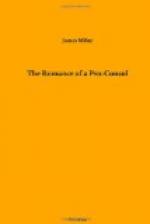‘Subjects occurred to me,’ he said, ’which I believed had not been given sufficient prominence, and this was one of them. I fancy Babbage wrote about it.’
Every motion, every word spoken, they agreed, abode an eternal influence in the world. Nothing, either in action or in reasoning, was lost; the unborn ages made response. If we could go back far enough we should be able to trace, by the influence it had wrought, that red streak, the murder of Abel. Had we a divine intellect, we could see the whole universe, a complete machine, at work. Sir George would marvel at the splendour of that creation, asking himself, ’Might it, if fully revealed, not be all too dazzling for human eyes?’
The Aborigine—Australian, Maori, and Kaffir—was to him a guarantee, by physical evidence, of the same law of the universe. They three had passed intimately before him, and he had mapped the intertwine of their paths. These were noteworthy, being a fruit of Sir George’s observation on the human race in primitive lands. First, consider the women, who, among barbarians, not having animals of burden, had always been pack horses.
‘In New Zealand,’ he said, ’with its forests, the females had to carry their loads along narrow paths. The proper way to carry a pack is on the head, but the trees made that impossible. Hills, too, had often to be climbed, and to ease the ascent a bending posture must be taken. Add that fact to the load on the back, and it was a consequence that Maori women should evolve clumsy figures.
’In Australia there was more open ground, and in many parts the method was to carry a load on the head. Thus, the native women were better of figure, though quite unequal to their 116 the romance of A Pro-Consul. lithe, graceful Kaffir sisters of South Africa. Here the country was free and open, and the carrying of a weight on the head naturally followed.’ Second, the men of those races.
‘The Australians,’ Sir George went on, ’were hunters, and had to climb trees in search of opossums. They drove holes into the trunks with their stone axes, dug in their big toes, and ascended. Such efforts provided them with long legs, while, again, they walked with turned-in toes. Why? Having scrub to penetrate, they must cut roads through it—a tiresome labour, not pursued more than was necessary. If they turned in their toes, they could sidle along a mere bee-line of clearing.
’The Maoris were very short in the limbs, this arising from the amount of time they spent in their canoes. Peculiarities of environment equally distinguish the Kaffirs, who were the most agile of the three races. Set against any of the others, all in the primitive state, the Kaffirs might have prevailed, though who could say? Neither the Maoris, nor the Australians, worked in iron weapons, while the Kaffirs did, and that circumstance would have told, in the clash of prevailing or going down.’




